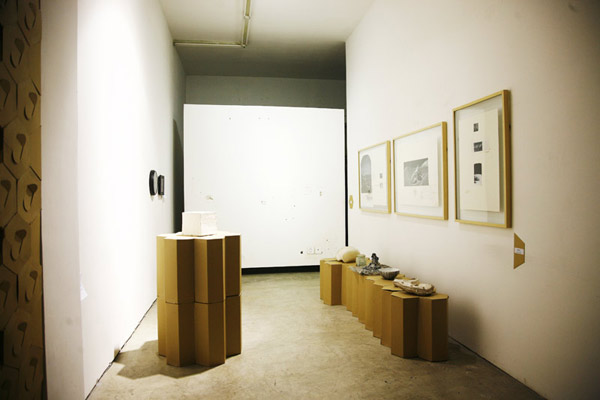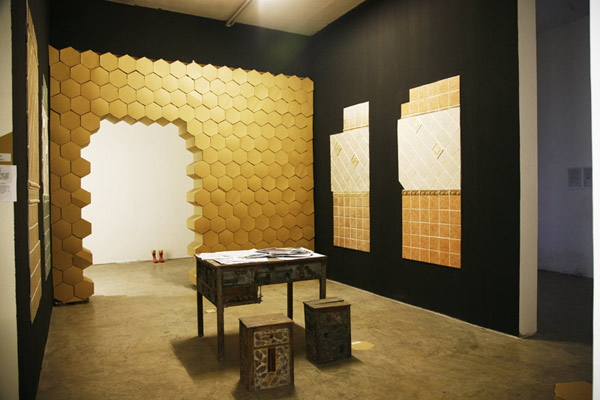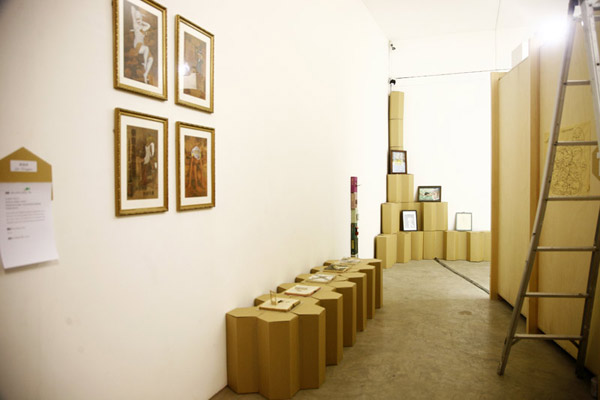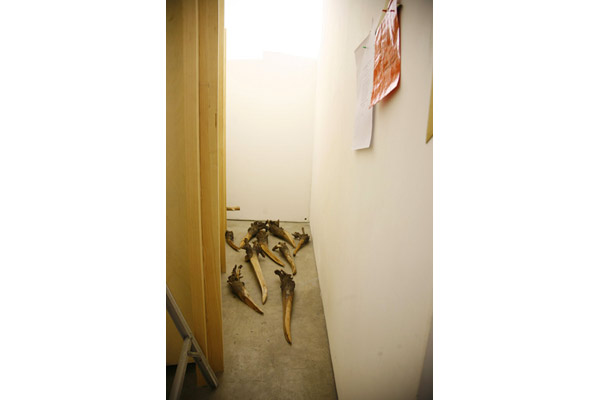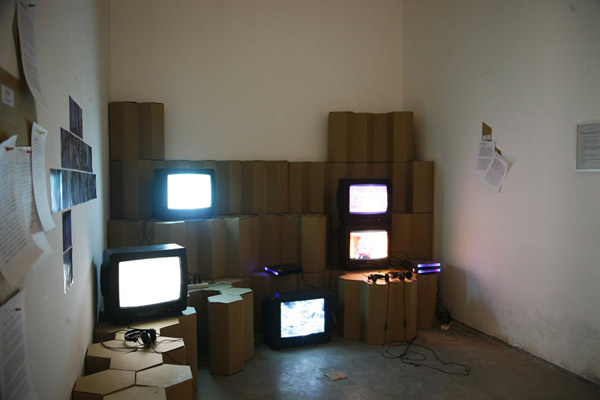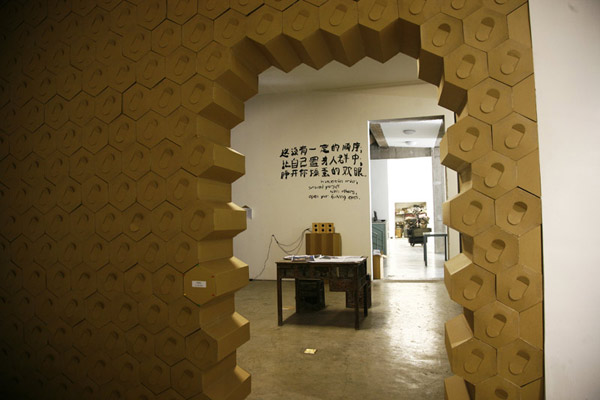An Exhibition in Three Acts
November 11, 2010 – January 24, 2011
Platform China Contemporary Art Institute | Beijing, CN
curator :: Beatrice LEANZA
And what would art have to do with this? What would it give to be seen? Cause to be seen? Let us see? Let us cause to be seen? Or let itself be shown?
Jacques DERRIDA, The Truth in Painting
The Third Party is an exhibition conceived to unfold in three consecutive sessions in Platform China project space. Each approximately lasting twenty days, the three moments of this show are devised to disclose their conceptual and thematic associations as in a chain‐reaction, where the individual frameworks are determined by the critical inputs presented within a preceding one. The Third Party explores the shaping relationships between narrative and aesthetic objects to foreground an inquiry in the realm of the ‘ordinary’ specific to the Chinese context. It does so by mobilizing overarching frames of reference and critique currently at play, be those aesthetic or historical, through three analytical environments tackling respectively issues of self-historicization, witnessing/archiving and collaboration. The progressive movement of the show somehow attends to the patterns of identification inherent in the day‐to‐day business of learning and communicating of and through our bodies, spaces, feelings as we build an understanding of reality and ultimately our position within it. The Third Party therefore concerns itself with matters of mapping, the tracing of patterns of both presence and absence and the ideological constitution of subjects.
The Third Party was chosen as “Best of 2011” in ArtForum, December 2011.
ACT 1. How to Be Alone (or Nowhere else am I safe from the question: why here?) | November 11 – 30, 2010
ACT 2. The Stranger | December 9 – 27, 2010
ACT 3. The Third Party – A Group Celebration! | January 7 – 24, 2011
ACT 1. How to Be Alone (or Nowhere else am I safe from the question: why here?)
November 11 – 30, 2010
participating artists :: GAO Mingyan, JIA Aili, JIN Shan, JIN Shi, Elaine W. HO, HU Xiangqian, HU Xiaoyuan, LI Jinghu, LI Naihan, LI Ming, LI Mu, LIANG Shuo, QIU Xiaofei, SUN Xun, WANG Wei, YAN Jun, YANG Xinguang, ZHANG Enli, ZHAO Yao, ZHOU Yilun
Perhaps one of the strongest models of presumed disjunction between everyday life and art, […] is presented in the invisible social space of reading and writing, a space defined temporally and spatially as outside and above the quotidian.
Susan STEWART, “On Longing”
With no precise point of origin, this journey through the regions of the ordinary draws itself by all manners of distantiation, through acts of arbitrary undoing or unframing of the seemingly perpetual ‘ongoingness’ of the real world. Like the book written by Jonathan FRENZEN from which it takes its title, the exhibition How to Be Alone is not a work of fiction. The ‘chapters’ that constitute it establish connections with the ‘local particulars’ of life in the present in the shape of very personal, provisional solutions or supplementary offerings to its spectacular overabundance of images, hegemonizing ideologies and policing strategies of communal existence. As the realm of the social grows overpopulated with the diversification of values and increasingly fractured throughout its cultural ephemera and material networks, ever more intricate and less tangible become the spaces for active participation, more subtle, immediate and intimate our strategies to survive within.
This exhibition wishes to highlight how, with no sense of exceptionalism, local artists respond to the demands of intellectual integrity by way of reconciling themselves and the outside world with reiterated acts of self‐positioning, exercised as forms of solipsistic performances that both distance and engage their cultural surrounding.This first exhibition as well as, we shall see, its second and third iteration, predicate themselves on a simple equation: one that matters the relationship between self and other, the creation of personal, isolated worlds that at the same time concern ‘me’ and ‘us’ as they provide a visual and material repository of contemporary history supplementary to the one offered in the public discourse of master narratives . It is ultimately, in the words of FRENZEN, “the problem of preserving individuality and complexity in a noisy and distracting mass culture: the question of how to be alone”.
ACT 2. The Stranger
December 9 – 27, 2010
participating artists :: CHEN Shaoxiong & LIU Ding, Rania HO, Elaine W. HO & Fotini LAZARIDOU-HATZIGOGA, YAN Lei
How can a subject give an account of its own ruin?
Giorgio AGAMBEN, from The Archive and Testimony
As the second enactment of this voyaging through the realm of the ordinary, The Stranger enters a very specific world of interaction, an intermediate zone of potentiality through which different manners of human relations come ‘to be lived rather than resolved’. The stranger is, as described in the eponymous essay by Georg SIMMEL in 1908, the sociological form that represents a unity of both fixation and liberation, “a particular structure composed of distance and nearness, indifference and involvement”. His position within a given group is “determined, essentially, by the fact that he has not belonged to it from the beginning, that he imports qualities into it, which do not and cannot stem from the group itself”. For what matters the investigation of narrative structures and aesthetic objects set out with the realization of this project, this second exhibition chooses to engage forms of artistic enunciations that dwell in the ‘negative side of presence’. More precisely, it exposes how they operate in relation to the exterior landscape by transforming or re-assembling into new spatial configurations specific orders of signification belonging to our living image- and object-scapes.
As the first part of this project, this second chapter looks at how aesthetic strategies ‘behave’ in relation to their immediate context by simultaneously engaging and removing themselves from its habitual order, that is how they manipulate the haptic and conceptual fields of social perception into alternative forms of narrative articulations. Unlike those seen in the first act of the exhibition, the artistic practices here selected do not operate in the register of sensate perception, but within a more general economy of aesthetics intended as the arena where symbolic and ideological systems of power are being constructed. The artists and projects included in The Stranger make manifest the intrinsic structures and processes by which the collective temporality and materiality of the present is archived in the ‘objective truths and facts’ of public consciousness and through which we inherit knowledge of official historical and social orders.
ACT 3. The Third Party – A Group Celebration!
January 7 – 24, 2011
An artist intent on casting off all restrictive conditions can only do so after he has clarified the relationship among artistic activity, artwork, and the public. […] The key isn’t to alter one’s language or the public’s involvement, but rather to change the artistic relationship between viewing and being viewed.
ZHANG Peili, The Point of Departure for Art Project No. 2; 1988
participants :: 8633 LINK (Beijing), ARROW FACTORY (Beijing), ARTHUB ASIA (Davide QUADRIO, Bangkok; Defne AYAS, Shanghai), BAO Atelier (Beatrice LEANZA & LI Naihan; Beijing), CAEP – Complete Art Experience Project (Beijing), ChART Contemporary/Open House (Megan & KC Vienna CONNOLLY; Beijing), COMFORTABLE COLLECTIVE (Shanghai), COMPANY (CHEN Zhou/LI Ming/LI Ran/YAN Xing; Hangzhou/Beijing), DDM Warehouse (ZHENG Weimin; Shanghai), DONKEY INSTITUTE of CONTEMPORARY ART (Michael YUEN/Yam LAU; Beijing), DOUBLE FLY ART CENTRE (Hangzhou/Shanghai), EVERYONE’S EAST LAKE Art Project (LI Juchuan; Wuhan), FALLING BEHIND (Beijing); FORGET ART Art Collective (Beijing), KNOWLES EDDY KNOWLES group (Beijing), HOMESHOP (Beijing), JIN Shan, LITTLE MOVEMENTS project (LIU Ding, Carol LU), LIBRERIA BORGES (CHEN Tong; Guangzhou), Peter ZHANG/SU Chang for Mommy Foundation (Biljana CIRIC; Shanghai/Beijing), OBSERVATION SOCIETY (Guangzhou), SHAN Studio (SHENG Jie aka GogoJ; Beijing), SUBJAM (YAN Jun; Beijing)
The last installment of The Third Party is dubbed “The Third Party – A Group Celebration!”
The two hyphenated parts of the title intend to heighten the inherent circularity proper of the progressive movement of the overall project. Unlike a literary composition plotted on exclusionary sequences of cause and effect, The Third Party plays with strategies of association, the tracing of patterns of presence and absence that both distance and engage themselves. Not a coda nor a gran finale, this last enactment does not represent a moment of synthesis nor of disruption of former orders; on the contrary it moves further into another, alternative perceptual context that both contains and expands the scope of preceding ones.
The critical extensions of the dimension of ‘collaboration’ span over a century-long history of theoretical and practical forays bridging the artistic and the social sphere.
Threaded through the genealogy of so called socially-engaged, relational practices, the deconstructive expanse of collaborative ventures in art making embraces creation as a dialogical process or oblique positioning engendering alternative forms of consensus building, promoting a participative and active pronunciation of will and independent thinking capable to bend the existing relations of power and production policing specific social constituencies. Likewise in the history of Chinese art the subversive force of collaboration recurs as both subject and object of artistic and intellectual pursuits reacting to the contextual conditions or limitations defined by overarching socio-political institutions found inadequate or simply unresponsive.
Various balancing forces motivate the practices here presented, arguably no less politically or controversially responsive to the established systems that cannot or will not accommodate them, than its historical precursors. Challenging social or aesthetic conventions and operating on varying degrees of specificity to the sites and constituencies they are inscribed in, they compose a picture where the individual limits of conceptual and material resources are overcome by means of a supplementary, collective strategy through which a ‘perceived lack or inconsistency’ comes to be lived rather than resolved.

